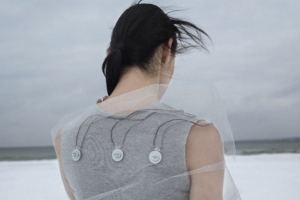Non-Degree / Dates: 17-21 July 2023
How do you think, could a dress or a jacket make you feel more confident, evoke pleasant memories, or communicate the emotions of your partner at a distance? Yes, it certainly can. By joining this course, you will find out not only how but will create your own vibrotactile feedback embedded in a wearable form, such as a garment or an accessory.
This one-week hands-on experimental course will introduce core design principles related to novel wearable technology with a focus on vibrotactile feedback. The main goal is to explore how to design and build wearables that communicate rich information via tactile sense.
During the first half of the course the students will learn the fundamental design principle for wearables, then will dive deeper into vibrotactile feedback and how it can be designed to communicate rich information.
During the second half of the course, the students will work in groups to first ideate, then create the vibrotactile patterns to convey information for the selected user scenario. The students will work with the specialized software to create vibrotactile patterns and will use Arduino controllers, and actuators to build high-fidelity prototypes.
The outcome of the course is to design and build a working wearable prototype that can be used for evaluation.
During the course, the students will be supported by experts in Interaction Design and Haptics, Smart Textiles, and Arduino programming engineers.
Why this course?
Teacher(s)
Yulia Zhiglova, Junior Researcher of the Human-Computer Interaction group in Tallinn University. In her research, she investigates how vibrotactile displays, embedded in wearable forms, may enable implicit behavior and self-perception change.
Vladimir Tomberg, PhD, Associate Professor of Interaction design in Tallinn University.
Timetable
Classes take place each week from Monday to Friday. The lectures are planned for each day 10:00 – 14:00.
Participants
Although this course welcomes everyone who is interested in wearable tech and who possesses knowledge of interaction design and software/hardware development, we believe that the game designers, fashion designers, and product designers from both creative and health and well-being industries will benefit the most.
The course is limited to 16 participants.
Credit points
Upon full participation and completion of course work students will be awarded 2 ECTS points and a diploma of completion.
Course fee
| Early-Bird Course Fee (until 31 March) | 260€ |
| Regular Course Fee (after 31 March) | 310€ |
Accommodation, cultural programme and meals are not included in the the price.
Covid-19 Restrictions
NB! When travelling to Estonia, the requirements established in Estonia must be followed. Read about them from kriis.ee website.
Please note that restrictions may change depending on the decision made by the Estonian Government. We highly recommend taking out insurance coverage.


